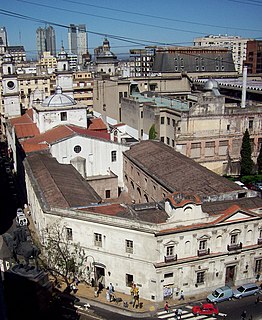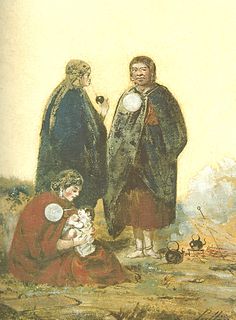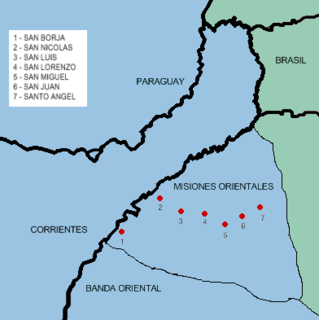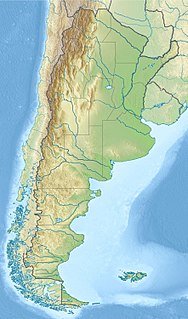 W
WColonial Argentina is designated as the period of the History of Argentina when it was an overseas territory of the Spanish Empire. It begins in the Precolumbian age of the indigenous peoples of Argentina, with the arrival of the first Spanish conqueror.
 W
WThe Viceroyalty of the Río de la Plata was the last to be organized and also the shortest-lived of the Viceroyalties of the Spanish Empire in the Americas.
 W
WNew León Governorate or Magellanic Lands (1529−?) was one of the colonial governorates of the Spanish Empire, located in southern South America.
 W
WGuayrá was a historical region of the Spanish Empire, located in the Governorate of Paraguay, within the colonial Viceroyalty of Peru. The region is located in present-day Paraguay and Paraná.
 W
WThe Illuminated Block is a historical landmark in the Monserrat neighbourhood of Buenos Aires, Argentina.
 W
WArgentina has 35 indigenous groups according to the Complementary Survey of the Indigenous Peoples of 2004, the Argentine government's first attempt in nearly 100 years to recognize and classify the population according to ethnicity. In the survey, based on self-identification or self-ascription, around 600,000 Argentines declared to be Amerindian or first-generation descendants of Amerindians, that is, 1.49% of the population. The most populous indigenous groups were the Aonikenk, Kolla, Qom, Wichí, Diaguita, Mocoví, Huarpe peoples, Mapuche and Guarani In the 2010 census [INDEC], 955,032 Argentines declared to be Amerindian or first-generation descendants of Amerindians, that is, 2.38% of the population. Many Argentines also identify as having at least one indigenous ancestor; a genetic study conducted by the University of Buenos Aires in 2011 showed that more than 56% of the 320 Argentines sampled were shown to have at least one indigenous ancestor in one parental lineage and around 11% had indigenous ancestors in both parental lineages.
 W
WMalón is the name given to plunder raids carried out by Mapuche warriors, who rode horses into Spanish, Chilean and Argentine territories from the 17th to the 19th centuries, as well as to their attacks on rival Mapuche factions. Historian Juan Ignacio Molina said the Mapuche considered the malón to be a means of obtaining justice:The injured family often assumes the right of pursuing the aggressor or his relations, and of punishing them. From this abuse are derived the denominations and distinctions, so much used in their jurisprudence, of genguerin, genguman, gerila, &c. denoting the principal connections of the aggressor, of the injured, or the deceased, who are supposed to be authorized, by the laws of nature, to support by force the rights of their relatives. When those who are at enmity have a considerable number of adherents, they mutually make incursions upon each other's possessions, where they destroy or burn all that they cannot carry off. These private quarrels, called malones, resemble much the feuds of the ancient Germans, and are very dreadful when the Ulmenes are concerned, in which case they become real civil wars. But it must be acknowledged that they are generally unaccompanied with the effusion of blood, and are confined to pillage alone. This people, notwithstanding their propensity to violence, rarely employ arms in their private quarrels, but decide them with the fist or with the club.
 W
WThe Misiones Orientales (Spanish) or Sete Povos das Missões/Siete Pueblos de las Misiones (Portuguese) are a historic region in South America, in present-day Rio Grande do Sul, the southernmost State of Brazil.
 W
WNew Andalusia Governorate was one of the colonial governorates of the Spanish Empire, located in southern South America.
 W
WThe Real Audiencia de Buenos Aires, were two audiencias, or highest courts, of the Spanish crown, which lived in Buenos Aires. The authority of the first extended to the territory of the Governorate of the Río de la Plata and operated from 1661 to 1671. The second began to function in 1783 and had as its territory the areas of the Viceroyalty of the Río de la Plata not covered by the Audiencia de Charcas, that is to say the intendancies of Buenos Aires, Córdoba del Tucumán, Salta del Tucumán and Paraguay. In 1810, after the May Revolution, it was suspended, and in 1813 the Assembly of the Year XIII permanently disbanded it. The Audiencias lived in the city's cabildo building.
 W
WSancti Spiritu was a fortification established in 1527 near the Paraná River by the explorer Sebastian Cabot. It was the first European settlement in the territory of modern Argentina and was destroyed by Amerindians two years later.
 W
WThe United Provinces of the Río de la Plata, earlier known as the United Provinces of South America, a union of provinces in the Río de la Plata region of South America, emerged from the May Revolution in 1810 and the Argentine War of Independence of 1810–1818. It comprised most of the former Viceroyalty of the Río de la Plata dependencies and had Buenos Aires as its capital.
 W
W